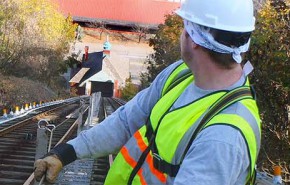What does the “true cost of a workplace incident” really mean? In general, this phrase broadly refers to both human and financial costs, which are often higher than most people realize.
Even the most minor of injuries—which may involve a brief trip to an outpatient clinic or even emergency room, but no time off or restriction to work duties—creates a variety of problems for workers. And as the seriousness of injuries increases, so do the resulting problems. In conjunction with North American Occupational Safety and Health Week, GAI Consultants takes a closer look at the true cost of a workplace incident and why it’s important for companies to understand the wide range of consequences—whether hidden or obvious, measurable or immeasurable.
Mental Impacts on Employees and Coworkers
When a workplace incident requires time off, it is not uncommon for the returning worker to experience some anxiety on the first day back. The employee may not even be aware of it, but stress from the incident can affect concentration and ability to perform job duties. They may also experience some minor embarrassment or concern for their reputation, depending on what happened. Coworkers of the injured employee may also have concerns about whether or not s/he is able to perform their job and may feel a need to help care for them. For more serious workplace incidents, significant problems such as flashbacks or panic attacks are common for the injured worker and those who witnessed the incident.
Impacts on Family and Friends
Injuries don’t just affect the employee and their coworkers—family and friends also share in the consequences. After a workplace incident, an injured family member may need help getting to doctor visits and physical therapy, or more assistance at home, requiring others to pitch in and possibly miss work themselves. Children who live at home, especially younger ones, might not understand the full extent of the injury, but may sense that the stress level in the home has risen. Their behaviors could regress as they seek to reestablish their sense of “normalcy.” Older children who understand what happened to their parent/caregiver might worry on a different level. Their daily lives could change if they are called on to do more at home or if they must give up outside activities.
Impact on Employee Finances
Family finances are also commonly affected by workplace incidents. Employees who require time off and are involved in the Workers’ Compensation system don’t receive the same amount of compensation as their normal job. If their finances were already stretched or they remain off work for an extended period, the time off can create a cascading effect that can take years to undo once the employee returns to work.
Direct Costs to Employers
Beyond human cost, all workplace incidents create additional costs for employers. Some of the more obvious costs include downtime on the production floor/project tasks; time away from regular duties for staff to investigate the incident and implement corrective actions; increases in insurance premiums; overtime to cover for staff lost to injury; and fines from regulatory agencies. These costs are direct and easy to calculate, while others, such as damage to an organization’s reputation or employee morale, are not so easy to quantify.
Indirect Costs to Employers
Depending on each unique situation, the range of indirect costs can vary widely, but the current average runs anywhere from $4 to $10 per dollar of direct cost. So how does that add up? Taking into account an organization’s profit margin, indirect costs multiply the true cost of a workplace incident. For example, using the lowest end of the range ($4), a profit margin of 11%, and an incident with direct costs of $5,000, an organization would need to generate over $227,000 of project work to cover the incident cost. Increase the incident cost to $10,000, and the company’s “true cost” rises to almost half a million dollars.
The true cost of a workplace incident entails a vast array of human and financial consequences.
Experience Modification Rating and Workers’ Compensation Insurance
One final measure of cost to an organization is the ability to generate work based on the history of losses due to workplace incidents. This is where the Experience Modification Rating (EMR) becomes important. Insurance carriers use an organization’s EMR to determine the premium paid for Workers’ Compensation insurance. An EMR of 1.0 is average and reflects an organization whose loss history is what would be expected for the industry. Organizations whose loss history is better than the industry average have EMRs less than 1.0. The lower the number, the better the organization has performed, which results in discounts on Workers’ Compensation premiums. Conversely, EMRs greater than 1.0 reflect an organization whose loss history is worse than their industry average. Instead of being rewarded with lower premiums, the base premium cost is increased to cover the expected cost to the insurer.
EMRs are calculated based on loss history from the past four years, minus the most recent policy year. So a costly workplace incident doesn’t hit a company’s EMR number until as much as two years after it occurs, but affects the Workers’ Compensation premium for three full years.
Beyond just the resulting premium calculation, EMRs have become critical to organizations like GAI. More and more, potential and existing clients use the EMR as a qualifier for submitting project bids. Some clients create arbitrary cut-offs (usually anything over 1.0), which is an example of an indirect cost that may be the most complicated to calculate.
![]() As Health & Safety Director, Bill Gourdie is responsible for spearheading initiatives that help GAI comply with all applicable health, safety, and environmental regulations; client requirements; and corporate policies and procedures in order to maintain the safest possible working conditions for all employees. He supports and advances GAI’s commitment to safety by coordinating the development, implementation, and continuous improvement of the company’s Safety & Health Program to enhance its effectiveness and improve performance results. Bill may be reached by phone at 412.399.5219
As Health & Safety Director, Bill Gourdie is responsible for spearheading initiatives that help GAI comply with all applicable health, safety, and environmental regulations; client requirements; and corporate policies and procedures in order to maintain the safest possible working conditions for all employees. He supports and advances GAI’s commitment to safety by coordinating the development, implementation, and continuous improvement of the company’s Safety & Health Program to enhance its effectiveness and improve performance results. Bill may be reached by phone at 412.399.5219


